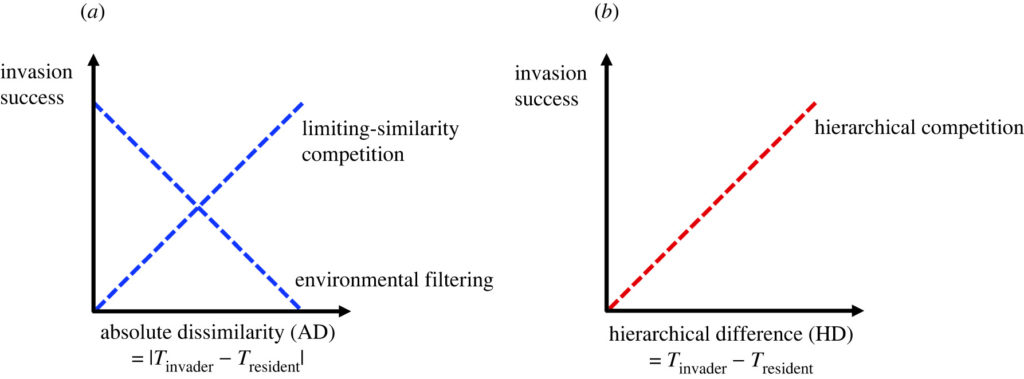New publication: how trait differences influence competition and invasions in ants

Different mechanisms involved in an invasion at the assemblage scale, and the expected relationships between invasion success and the invader’s trait differences.
Much of the beauty of biodiversity is found in the diverse physical characteristics or ‘traits’ of organisms, such as their different sizes, body plans, diets, and behaviours. As traits modulate species’ interactions with their environments, ecologists are increasingly studying the traits of species to gain insights into the mechanisms determining the assembly of ecological communities and their responses to disturbances. Traditionally, ecologists have taken differences between species’ traits to indicate differences in their niches, such as their use of different resources, and assumed that competitive exclusion between species occurs via limiting trait similarity. Yet ‘modern coexistence theory’ emphasises that trait differences can also distinguish species’ competitive abilities for the same resources, leading to the exclusion of weaker competitors. Increasingly, such competitive trait hierarchies have been observed to structure plant assemblages – for instance in traits linked to light capture. But few studies have explored whether competitive trait hierarchies may also structure animal communities or sought to understand their effects on functional diversity.

Abundance of the invader S. invicta as a function of its average trait differences with ant species in each of 61 plots
In his DPhil research, Mark Wong, now a Forrest Fellow in the Ecosystem Change Ecology team, conducted an integrative trait-based study to understand the drivers and consequences of an invasion by the red imported fire ant (Solenopsis invicta) on ant communities in Hong Kong. The work entailed an extensive sampling of ant communities, measurements of a novel and robust suite of ant traits encompassing their morphological structures, trophic positions, thermal tolerances and aggressive behaviours, as well as analytical approaches adopted from trait-based studies of plant communities. Recently published in Proceedings of the Royal Society B, the study found that S. invicta’s success in invading ant communities was not only driven by limiting similarity in body size and thermal tolerance – which presumably allowed S. invicta to exploit different niches from resident species – but also by S. invicta’s superior position in trait hierarchies reflecting competition for common trophic resources. Additionally, the study showed that these opposing mechanisms generated complex and contrasting patterns in the functional diversity of invaded communities, where co-occurring ant species were at once significantly similar or ‘clustered’ in some traits but significantly dissimilar or ‘overdispersed’ in others.
The findings of the study evidence the importance of both trait-mediated niche and competitive ability differences in determining coexistence and functional diversity patterns in animal communities. They also highlight that multiple assembly processes, even those with opposing effects, can simultaneously shape trait patterns in ecological communities. Ecologists attempting to infer process from pattern will hence need to navigate how such complexities play out along multiple trait axes.
For more on this study, check out the article here.
Wong MKL, Lee RH, Leong CM, Lewis OT & Guénard B. (2022). Trait-mediated competition drives an ant invasion and alters functional diversity Proceedings of the Royal Society B: Biological Sciences, 289, 20220504.
Photograph of S. invicta courtesy of Francois Brassard.